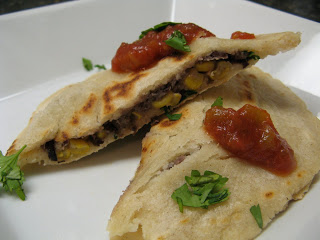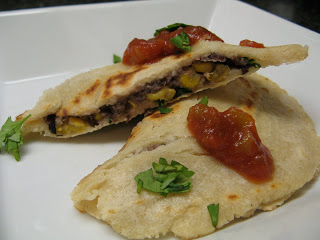 Pupusas are a traditional El Salvadorian dish made with corn flour dough and stuffed with cheese, beans, meat or other fillings. In some places, specialty versions are made with rice flour and even wheat flour (a gluten no-no). But prepared in the traditional way with the classic ingredients, this is a dish that’s naturally gluten-free.
Pupusas are a traditional El Salvadorian dish made with corn flour dough and stuffed with cheese, beans, meat or other fillings. In some places, specialty versions are made with rice flour and even wheat flour (a gluten no-no). But prepared in the traditional way with the classic ingredients, this is a dish that’s naturally gluten-free.
We were first introduced to pupusas by an El Salvadorian food vendor at our local farmers market. We enjoyed them so much, we had to come home and make our own version so that we could indulge more often. In order to actually form the pupusas, a ball of corn flour dough is pressed with the thumb to make a deep indentation. The filling is added, and the indentation is closed to seal in the filling. Then, the ball is flattened in a tortilla press.
For the life of us, we couldn’t get this method to work. Something always went wrong (usually resulting in the pupusa breaking open and leaking the filling). Instead, we utilized an alternate technique that seemed to work pretty well in its own right. Here’s how to make gluten-free pupusas:
 Start by preparing dough made from masa harina (instant corn flour, of which a popular brand is Maseca). Combine corn flour and water (and a pinch of salt) in a ratio of 1.5 parts corn flour to 1 part water. Form the dough into balls slightly larger than the size of a golf ball. Press the dough balls into “corn pancakes” about 5-6 inches in diameter.
Start by preparing dough made from masa harina (instant corn flour, of which a popular brand is Maseca). Combine corn flour and water (and a pinch of salt) in a ratio of 1.5 parts corn flour to 1 part water. Form the dough into balls slightly larger than the size of a golf ball. Press the dough balls into “corn pancakes” about 5-6 inches in diameter.There’s obviously a lot of wiggle room on the filling. For this version, we mashed some canned black beans, and seasoned them with salt, pepper, garlic powder, and dried cumin. To the beans we added whole corn kernels and some chopped cilantro. (We also made some that included some shredded quesadilla cheese.)
To assemble the pupusas, lay out the first corn pancake. Add a thin layer of filling, leaving a border of dough around the edge. Lay a second corn pancake over the top, and press the edges together to seal in the filling. Pan fry the pupusas with a little bit of olive oil in a frying pan or skillet, turning halfway through. You want to pan fry them enough so that the dough cooks and the filling heats through.
To finish off the dish, you can add a dollop of sour cream, a spoonful of salsa, a sprinkling of chopped fresh cilantro, or even a cilantro slaw.
But no matter how you prepare them, pupusas are a delicious dish that adds variety to the wonderful selection of gluten-free Latin American dishes available to us.
– Pete
Looks yummy! My husband’s been wanting me to make some and now I can. Thanks!
I had pupusas once in San Fransisco. Oh. So. Delicious. I tried to make them once, too, and they weren’t as good as I remembered. I think I’ll have to try again. Thanks for reminding me!
Enjoy the pupusas! They can be quite tasty made at home!
Cheers, Pete
I think I might know where part of the problem with forming them comes from: you lack lard.
Yup, lard. That magical substance that finds its way into many a Mexican and South American recipe.
Many masa dough recipes call for a little lard to be worked into the corn flour before adding water–much like a traditional pie crust recipe. It will give the dough a little more elasticity and a deeper flavor than plain masa and water.
It does make it rather more caloric and non-vegetarian though…
Hi Castal… Thanks for the tip about using lard! Much appreciated! We’ve sometimes used some corn oil for a similar effect…
Cheers, Pete
Yum! We made tamales last week and now I have some leftover flour. Pupusas are on the list. I had some great ones at Cafe Pasqual’s in Santa Fe a few months ago. Now to make them myself! Or you could try a mix of margarine and butter, that combo makes for good tamales…?
Oh yeah, I meant to ask, which farmer’s market? We are headed up next week to visit friends i Boulder and I love their FM, are the pupusas there? If so, we definitely have to go and get some chai at the tea house!!!
Hi BeyondRiceandTofu… Enjoy the pupusas! Personally, we’re not fans of using margarine, but butter could be an option. And yes, the pupusas in questions are from the Boulder Farmer’s Market, which runs on Wednesday afternoon/evening and Saturday mornings through early afternoon. Have fun!
Cheers, Pete
Just wondering if you can use masarepa (the corn flour used for arepas) for the pupusas?? They look delish and I’d love to try them.
Hi Ceilithe… There are some subtle differences between masarepa and masa harina / Maseca. Both are essentially pre-cooked corn meal, but masarepa isn’t treated with lime, and masarepa often has a coarser texture than masa harina. However, there’s no reason you couldn’t use it to make papusas, and some people do just that!
Cheers, Pete
Pupasas remind me of arepas, a Venezualen specialty. We’ve enjoyed these several times since I discovered them several months ago. Arepas are also made with the pre-cooked masa flour. But I see from your previous posts that there is a difference. I didn’t know that regular masa harina was pre-cooked. (I’ve also used a eastern European version designed to be a breakfast porridge, when I couldn’t get anywhere to get the proper arepas stuff.)
For those who don’t know, arepas are stuffed after the buns are cooked. Some recipes call for the arepas to be fried and then baked, others just specify one or the other. We’ve had trouble determining when they are done, but we keep on trying.
The three youtube videos done by bersaidavega are fun to watch and very informative. Here is part one
http://www.youtube.co/watch?v=o5OQlLYNqPU
There is also a video somewhere featuring two pairs of chefs from, I think, Brooklyn, participating in an arepas cook-off. It has many interesting filling ideas, but I can’t seem to find it just now. Perhaps a more saavy searcher can find it.
We’ll have to try pupasas sometime soon. They look good.
This is in regards to Castal’s comment. We never add lard to the masa for pupusas. If the masa breaks up when forming the pupusa, it is because the dough is too dry and needs more water. I learned this from my mother who makes the best pupusas.
I understand this post is 4 years old, but when I read the comment I had to respond.